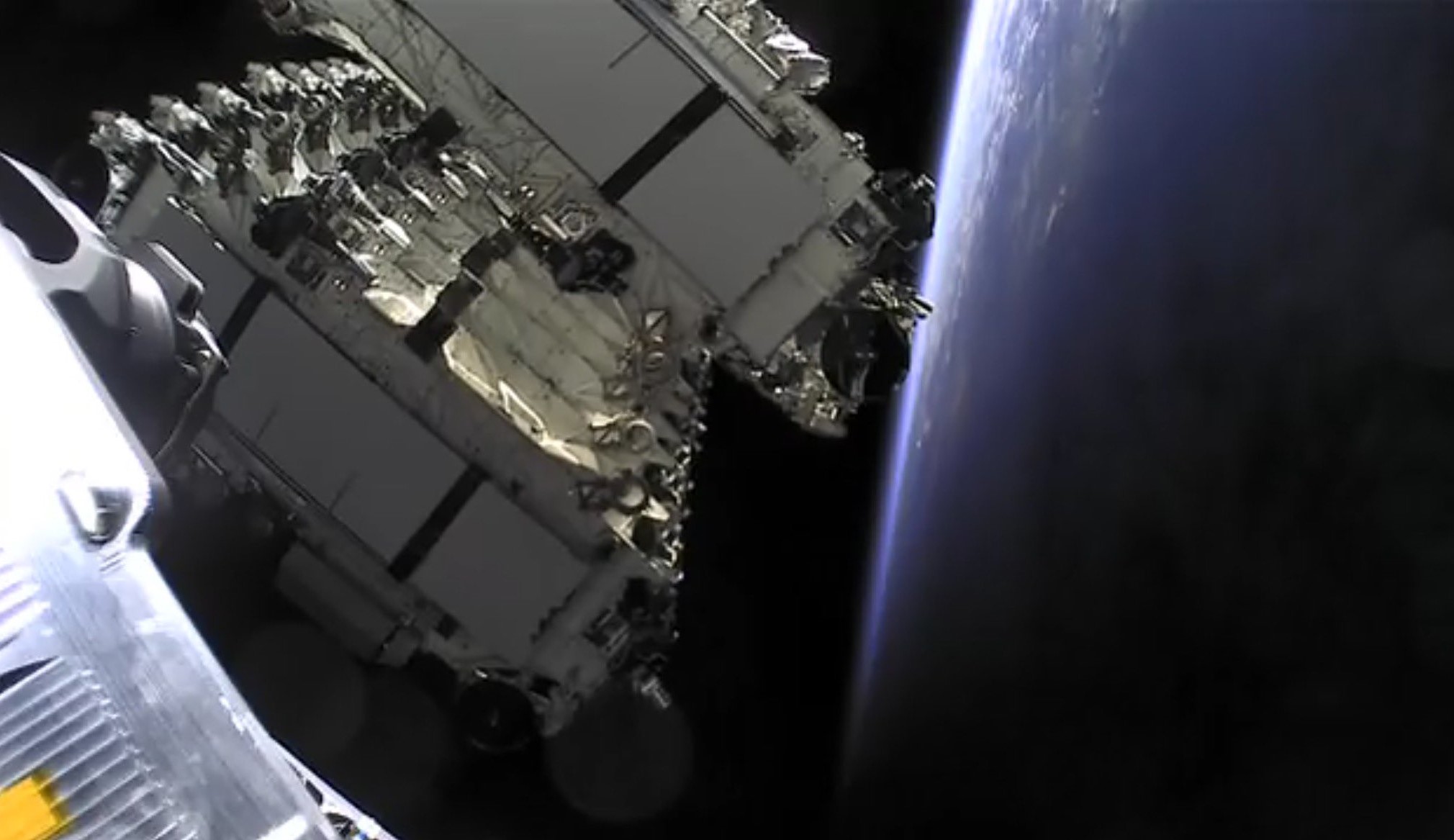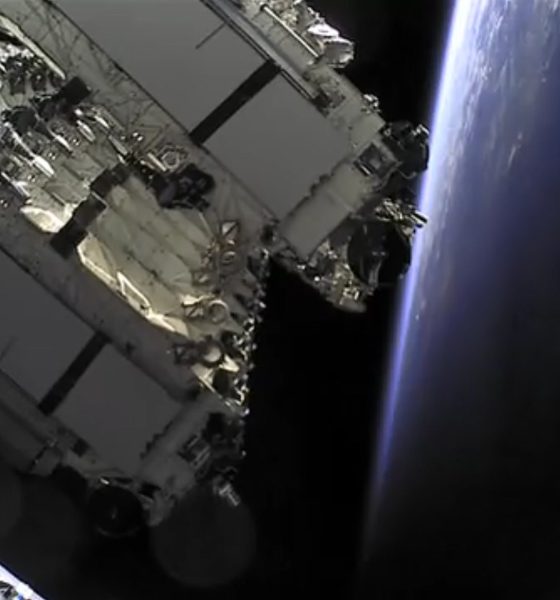

News
SpaceX loses dozens of new Starlink satellites to “geomagnetic storm”
SpaceX says that dozens of the 49 Starlink satellites aboard its most recent Starlink launch may have been doomed by a “geomagnetic storm” that arrived the day after.
In an update published on SpaceX.com, the company revealed that “up to 40 of the [49 Starlink V1.5] satellites [launched on February 3rd] will reenter or already have reentered the Earth’s atmosphere” after the “severity of the storm caused atmospheric drag to increase up to 50 percent higher” relative to past Starlink launches. The incident is likely the first time in spaceflight history that a geomagnetic storm – solar weather – has caused satellites to fail because of its effects on Earth’s atmosphere.
There’s some ambiguity in SpaceX’s statement as to how exactly the storm caused up to 40 Starlink satellites to fail or if those satellites actually failed, per se. According to SpaceX, a geomagnetic storm that began on February 4th caused “the atmosphere to warm and atmospheric density at [the mission’s] low deployment altitudes to increase [up to 50%],” thereby increasing the drag on each Starlink satellite by the same amount. SpaceX intentionally launches almost every batch of Starlink satellites to very low parking orbits with perigees (the point of the orbit closest to Earth) around 200 kilometers (125 mi).
At that altitude, both Falcon 9’s upper stage and malfunctioning Starlink satellites will naturally reenter Earth’s atmosphere in a matter of weeks or even days, thus guaranteeing that satellites that fail early on won’t become space debris. Only the Starlink satellites that pass initial testing in orbit are allowed to raise themselves to operational orbits around 550 kilometers (340 mi), where a failed satellite will instead take years to deorbit. Just 500 kilometers higher, natural decay takes decades or even centuries.
For Starlink 4-7, it’s ambiguous if the radiation environment created by the geomagnetic storm or days of exposure to the edge of the atmosphere actually damaged dozens of Starlink satellites beyond recovery or if they simply deorbited so quickly in the unusual environment that they fell past the point of no return. In the latter scenario, the incident is effectively an unforeseen fluke of nature – especially given that three-dozen other Starlink launches have run into no such issues in the last three years. In the fluke-of-nature scenario, it’s also unclear if SpaceX could have predicted – and thus prevented – the anomaly.

SpaceX says it “commanded the satellites into a safe-mode where they would fly edge-on (like a sheet of paper) to minimize drag” as soon as it was aware of the issue but that “the increased drag…prevented the satellites from leaving safe-mode to begin orbit raising maneuvers.” Based on that phrasing, the most obvious explanation is that the added drag caused up to 40 of the satellites to fall far enough into the atmosphere that their ion thrusters would no longer be able to raise their orbits faster than the drag was lowering them. Raising their solar arrays into the position needed for maximum power generation (and thus maximum sustained thrust) would also drastically accelerate reentry.
The 40 satellites SpaceX believes will be lost likely cost the company anywhere from $10 million to $40 million to build, making for a very expensive lesson. The anomaly also means that SpaceX will likely need to factor in yet another weather condition – geomagnetic storms – into Starlink launch planning. If a bit more time could have saved Starlink 4-7, it’s possible that the company will also consider slightly raising the low parking orbits used for Starlink, trading slightly slower natural reentries to reduce the risk of losing dozens of brand new satellites again.

Elon Musk
Elon Musk’s X will start using a Tesla-like software update strategy
The initiative seems designed to accelerate updates to the social media platform, while maintaining maximum transparency.

Elon Musk’s social media platform X will adopt a Tesla-esque approach to software updates for its algorithm.
The initiative seems designed to accelerate updates to the social media platform, while maintaining maximum transparency.
X’s updates to its updates
As per Musk in a post on X, the social media company will be making a new algorithm to determine what organic and advertising posts are recommended to users. These updates would then be repeated every four weeks.
“We will make the new 𝕏 algorithm, including all code used to determine what organic and advertising posts are recommended to users, open source in 7 days. This will be repeated every 4 weeks, with comprehensive developer notes, to help you understand what changed,” Musk wrote in his post.
The initiative somewhat mirrors Tesla’s over-the-air update model, where vehicle software is regularly refined and pushed to users with detailed release notes. This should allow users to better understand the details of X’s every update and foster a healthy feedback loop for the social media platform.
xAI and X
X, formerly Twitter, has been acquired by Elon Musk’s artificial intelligence startup, xAI last year. Since then, xAI has seen a rapid rise in valuation. Following the company’s the company’s upsized $20 billion Series E funding round, estimates now suggest that xAI is worth tens about $230 to $235 billion. That’s several times larger than Tesla when Elon Musk received his controversial 2018 CEO Performance Award.
As per xAI, the Series E funding round attracted a diverse group of investors, including Valor Equity Partners, Stepstone Group, Fidelity Management & Research Company, Qatar Investment Authority, MGX, and Baron Capital Group, among others. Strategic partners NVIDIA and Cisco Investments also continued support for building the world’s largest GPU clusters.
News
Tesla FSD Supervised wins MotorTrend’s Best Driver Assistance Award
The decision marks a notable reversal for the publication from prior years, with judges citing major real-world improvements that pushed Tesla’s latest FSD software ahead of every competing ADAS system.

Tesla’s Full Self-Driving (Supervised) system has been named the best driver-assistance technology on the market, earning top honors at the 2026 MotorTrend Best Tech Awards.
The decision marks a notable reversal for the publication from prior years, with judges citing major real-world improvements that pushed Tesla’s latest FSD software ahead of every competing ADAS system. And it wasn’t even close.
MotorTrend reverses course
MotorTrend awarded Tesla FSD (Supervised) its 2026 Best Tech Driver Assistance title after extensive testing of the latest v14 software. The publication acknowledged that it had previously criticized earlier versions of FSD for erratic behavior and near-miss incidents, ultimately favoring rivals such as GM’s Super Cruise in earlier evaluations.
According to MotorTrend, the newest iteration of FSD resolved many of those shortcomings. Testers said v14 showed far smoother behavior in complex urban scenarios, including unprotected left turns, traffic circles, emergency vehicles, and dense city streets. While the system still requires constant driver supervision, judges concluded that no other advanced driver-assistance system currently matches its breadth of capability.
Unlike rival systems that rely on combinations of cameras, radar, lidar, and mapped highways, Tesla’s FSD operates using a camera-only approach and is capable of driving on city streets, rural roads, and freeways. MotorTrend stated that pure utility, the ability to handle nearly all road types, ultimately separated FSD from competitors like Ford BlueCruise, GM Super Cruise, and BMW’s Highway Assistant.
High cost and high capability
MotorTrend also addressed FSD’s pricing, which remains significantly higher than rival systems. Tesla currently charges $8,000 for a one-time purchase or $99 per month for a subscription, compared with far lower upfront and subscription costs from other automakers. The publication noted that the premium is justified given FSD’s unmatched scope and continuous software evolution.
Safety remained a central focus of the evaluation. While testers reported collision-free operation over thousands of miles, they noted ongoing concerns around FSD’s configurable driving modes, including options that allow aggressive driving and speeds beyond posted limits. MotorTrend emphasized that, like all Level 2 systems, FSD still depends on a fully attentive human driver at all times.
Despite those caveats, the publication concluded that Tesla’s rapid software progress fundamentally reshaped the competitive landscape. For drivers seeking the most capable hands-on driver-assistance system available today, MotorTrend concluded Tesla FSD (Supervised) now stands alone at the top.
News
Elon Musk’s Grokipedia surges to 5.6M articles, almost 79% of English Wikipedia
The explosive growth marks a major milestone for the AI-powered online encyclopedia, which was launched by Elon Musk’s xAI just months ago.

Elon Musk’s Grokipedia has grown to an impressive 5,615,201 articles as of today, closing in on 79% of the English Wikipedia’s current total of 7,119,376 articles.
The explosive growth marks a major milestone for the AI-powered online encyclopedia, which was launched by Elon Musk’s xAI just months ago. Needless to say, it would only be a matter of time before Grokipedia exceeds English Wikipedia in sheer volume.
Grokipedia’s rapid growth
xAI’s vision for Grokipedia emphasizes neutrality, while Grok’s reasoning capabilities allow for fast drafting and fact-checking. When Elon Musk announced the initiative in late September 2025, he noted that Grokipedia would be an improvement to Wikipedia because it would be designed to avoid bias.
At the time, Musk noted that Grokipedia “is a necessary step towards the xAI goal of understanding the Universe.”
Grokipedia was launched in late October, and while xAI was careful to list it only as Version 0.1 at the time, the online encyclopedia immediately earned praise. Wikipedia co-founder Larry Sanger highlighted the project’s innovative approach, noting how it leverages AI to fill knowledge gaps and enable rapid updates. Netizens also observed how Grokipedia tends to present articles in a more objective manner compared to Wikipedia, which is edited by humans.
Elon Musk’s ambitious plans
With 5,615,201 total articles, Grokipedia has now grown to almost 79% of English Wikipedia’s article base. This is incredibly quick, though Grokipedia remains text-only for now. xAI, for its part, has now updated the online encyclopedia’s iteration to v0.2.
Elon Musk has shared bold ideas for Grokipedia, including sending a record of the entire knowledge base to space as part of xAI’s mission to preserve and expand human understanding. At some point, Musk stated that Grokipedia will be renamed to Encyclopedia Galactica, and it will be sent to the cosmos.
“When Grokipedia is good enough (long way to go), we will change the name to Encyclopedia Galactica. It will be an open source distillation of all knowledge, including audio, images and video. Join xAI to help build the sci-fi version of the Library of Alexandria!” Musk wrote, adding in a later post that “Copies will be etched in stone and sent to the Moon, Mars and beyond. This time, it will not be lost.”








